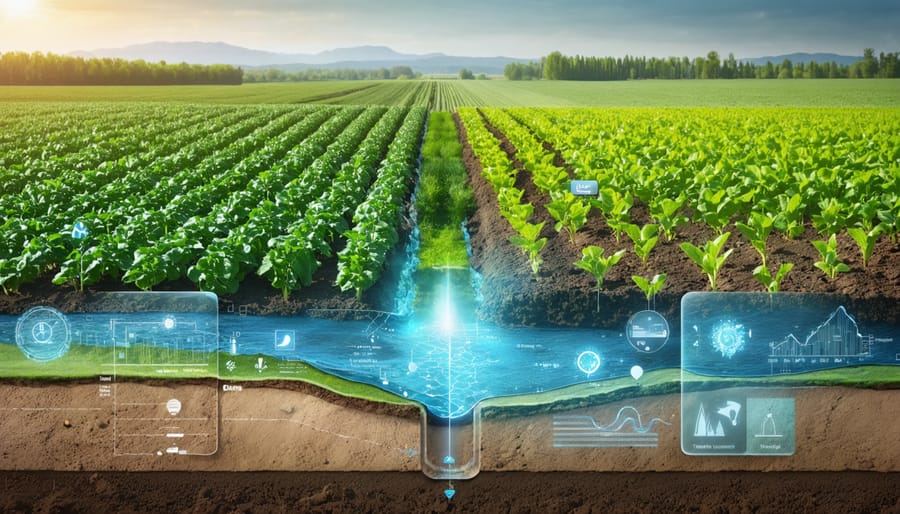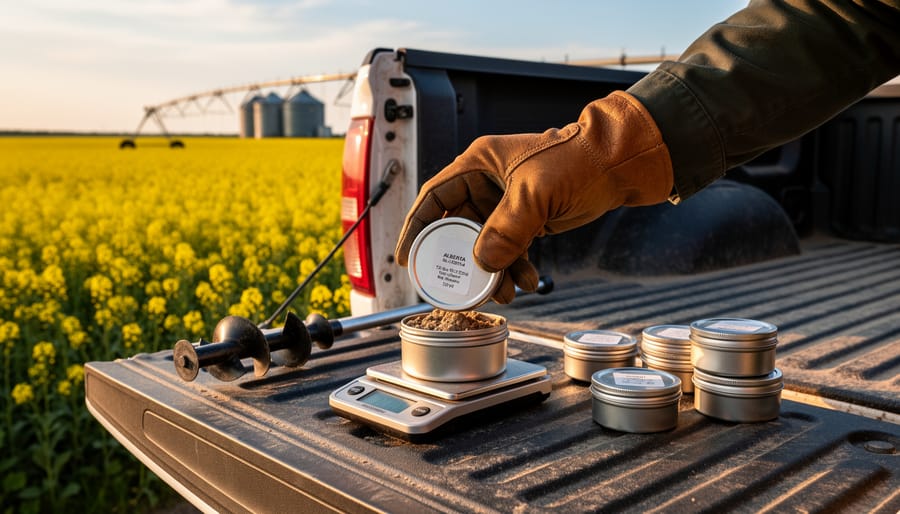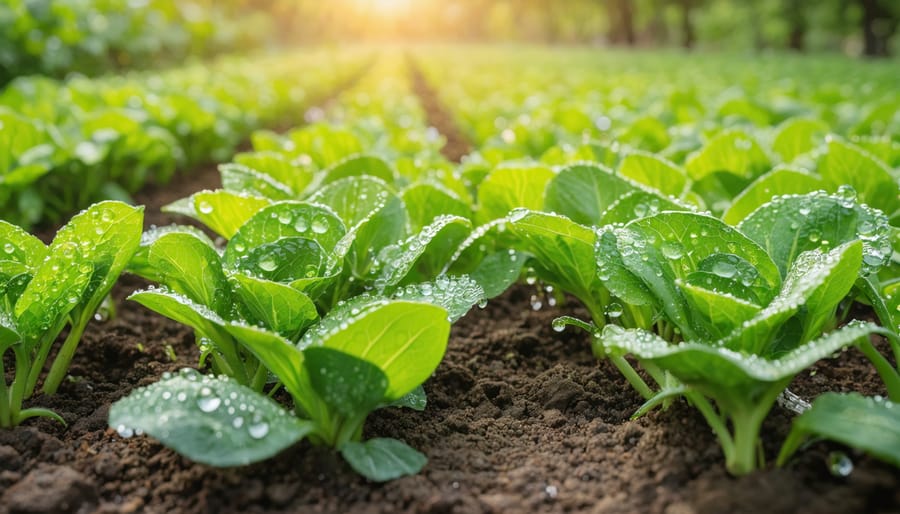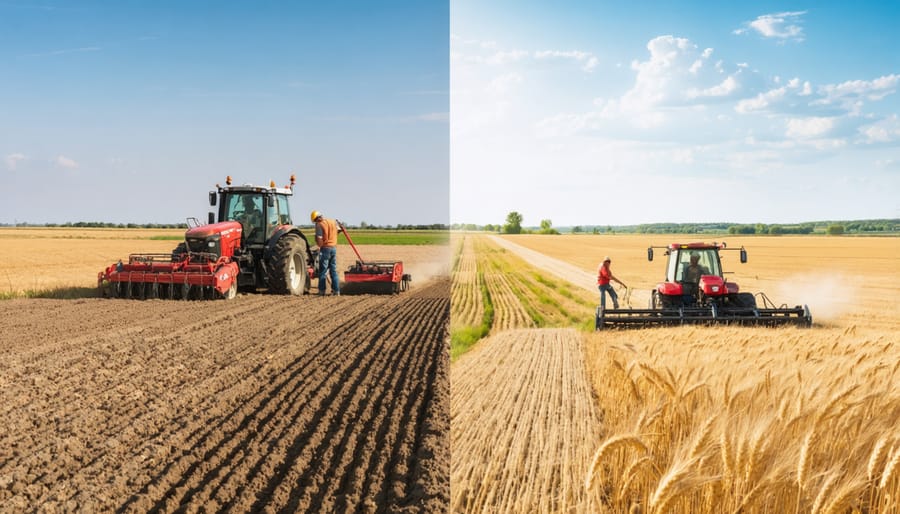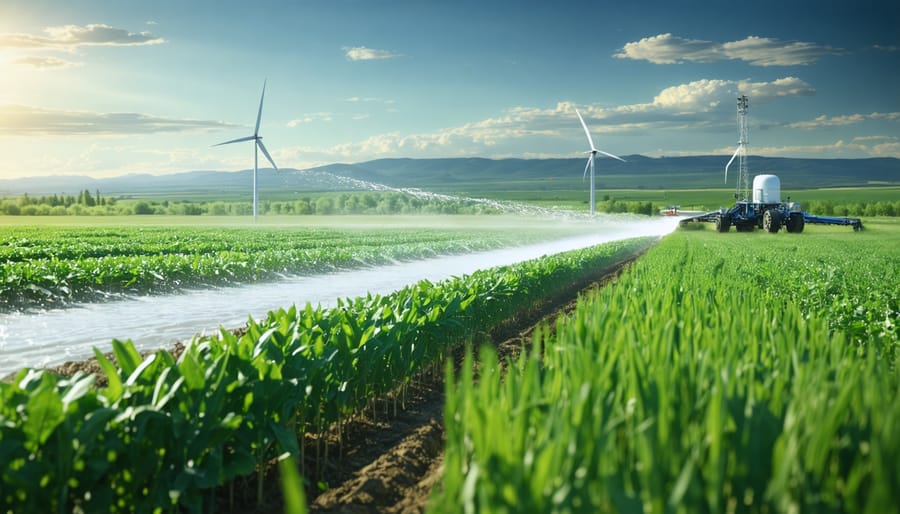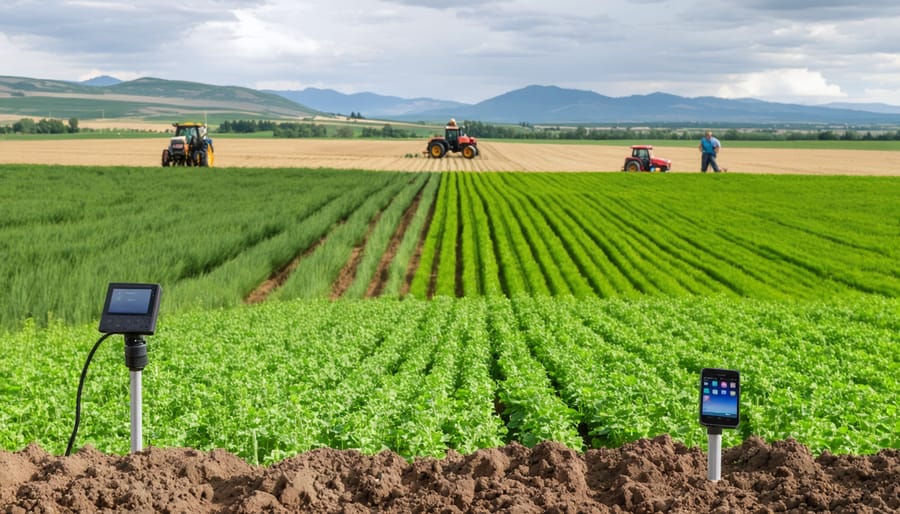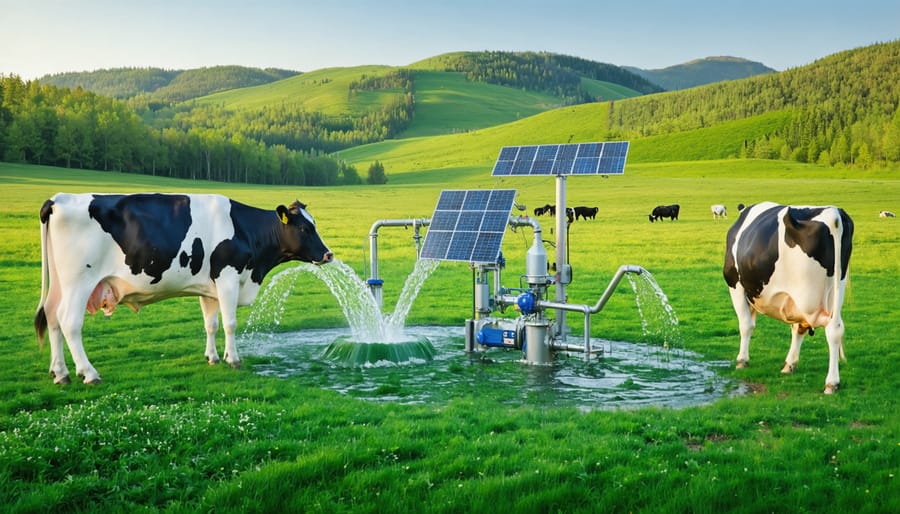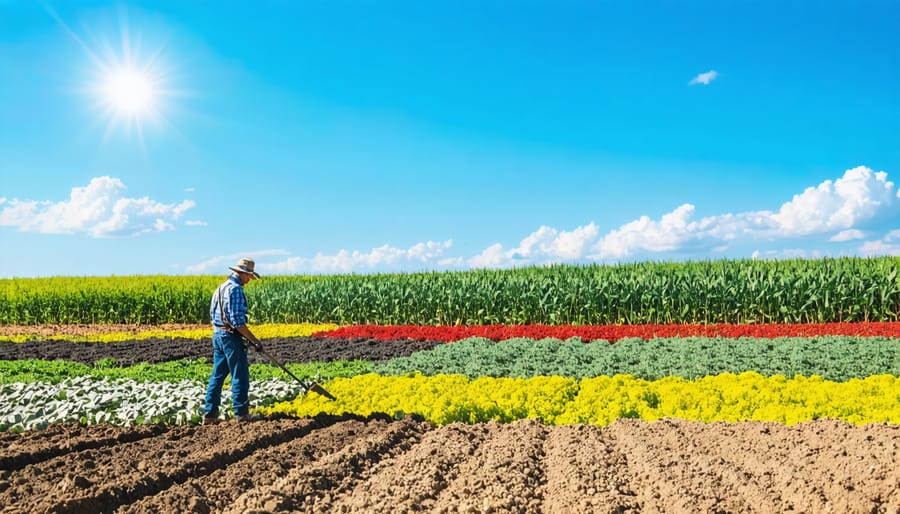Groundwater management stands as a cornerstone of sustainable agriculture in Alberta, where over 600,000 rural residents rely on aquifers for their daily water needs. Managing this vital resource requires a delicate balance between current agricultural demands and long-term conservation efforts. For Alberta farmers, effective groundwater stewardship combines scientific monitoring, regulatory compliance, and practical field management techniques.
The increasing pressure on groundwater resources, coupled with climate variability and expanding agricultural operations, has made strategic water management more critical than ever. Recent studies show that nearly 30% of Alberta’s agricultural regions face moderate to high risks of groundwater depletion. However, innovative management practices and modern monitoring technologies are enabling farmers to optimize their water use while protecting these essential underground reservoirs.
By understanding the complex interplay between soil conditions, precipitation patterns, and aquifer recharge rates, Alberta’s agricultural community is pioneering sustainable groundwater practices that ensure both productive farming and resource preservation. This comprehensive approach to groundwater management not only safeguards our water resources for future generations but also enhances farm productivity and economic resilience in an era of increasing environmental challenges.
The State of Alberta’s Groundwater Resources
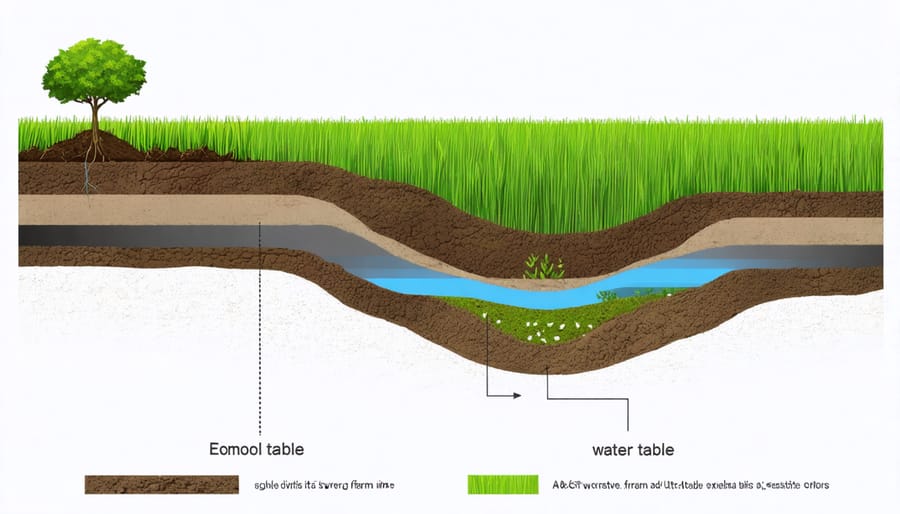
Understanding Your Farm’s Water Table
Understanding your farm’s water table is crucial for successful agricultural operations in Alberta. Start by identifying existing wells on your property and reviewing historical water level records if available. Regular monitoring of water levels can be done using a water level meter or sonic measuring device, with measurements taken at consistent intervals throughout the year.
Consider installing observation wells at strategic locations across your property to track seasonal fluctuations. These monitoring points should be placed in areas with different elevations and soil types to get a comprehensive picture of your groundwater system. In Alberta’s climate, it’s recommended to take measurements at least quarterly, with additional readings during spring melt and after significant rainfall events.
Watch for warning signs of changing water tables, such as decreasing well yields, changes in water quality, or newly wet areas in fields. Local geology plays a significant role in water table behavior – areas with sandy soils may see faster changes than those with clay-based soils.
Keep detailed records of your measurements, including dates, weather conditions, and any unusual observations. This data becomes invaluable for long-term water management planning and can help identify trends that might affect your farming operations.
Key Factors Affecting Groundwater Quality
The quality of groundwater in Alberta’s agricultural regions depends on both natural processes and human activities. Our soil’s natural groundwater filtration capabilities play a crucial role, but several key factors can affect water quality.
Geological composition significantly influences groundwater quality, with different soil types and rock formations affecting mineral content and filtration efficiency. Natural factors like precipitation patterns and seasonal temperature variations also impact water quality by affecting recharge rates and dissolved mineral concentrations.
Human activities on our farms can have substantial effects. Agricultural practices, including fertilizer application, manure management, and pesticide use, can influence groundwater quality if not properly managed. Well maintenance and construction also play vital roles – properly sealed and maintained wells help prevent surface contaminants from entering the groundwater system.
Industrial activities near farming regions and waste disposal practices in rural areas can introduce additional challenges. Understanding these factors helps us make informed decisions about land use and implement protective measures for our groundwater resources. Regular water quality testing and monitoring help us track changes and adjust our management practices accordingly.
Practical Water Conservation Techniques
Smart Irrigation Systems
Modern groundwater irrigation systems have revolutionized how Alberta farmers manage their water resources. These innovative technologies combine precision sensors, weather monitoring, and automated controls to deliver water exactly when and where crops need it.
Local success stories, like the Meyer family farm near Taber, demonstrate how soil moisture sensors and automated sprinkler systems can reduce water usage by up to 30% while maintaining or improving crop yields. These systems use real-time data to adjust irrigation schedules based on soil conditions, weather forecasts, and crop growth stages.
Variable rate irrigation (VRI) technology has become increasingly popular among Alberta producers, allowing for customized water application across different field zones. This technology considers factors like soil type, topography, and crop requirements to optimize water distribution.
Smart scheduling strategies complement these systems effectively. Many farmers now use mobile apps that integrate data from multiple sources to create precise irrigation schedules. These tools factor in local weather patterns, soil moisture levels, and crop water requirements to determine optimal irrigation timing.
For smaller operations, simple innovations like moisture probes and timer-based systems offer cost-effective solutions. The Alberta Irrigation Technology Centre provides resources and training to help farmers select and implement the right technology for their specific needs, ensuring both water conservation and crop productivity.
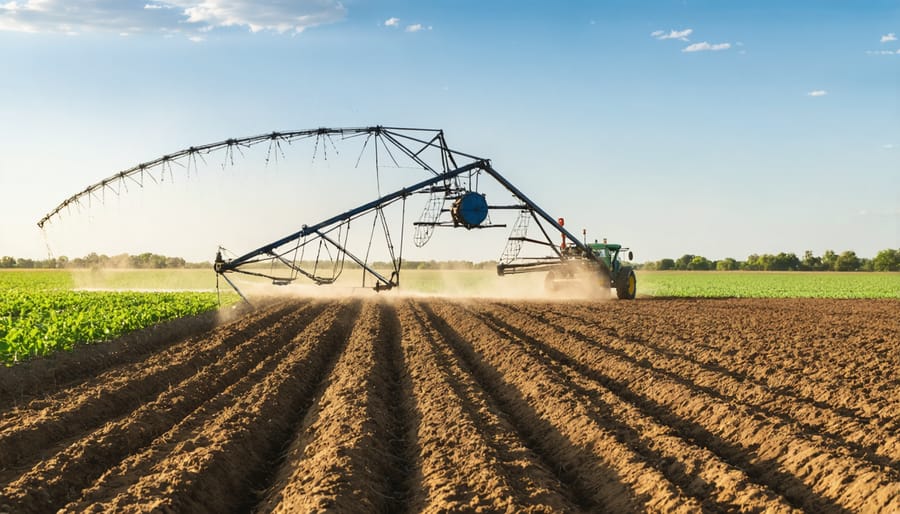
Soil Management for Better Water Retention
Effective soil management is crucial for maximizing groundwater efficiency on Alberta farms. By implementing strategic practices, farmers can significantly improve soil moisture retention and reduce their reliance on irrigation.
Adding organic matter through cover crops and crop residue management helps create a soil structure that holds water better. Many Alberta farmers have found success with minimum tillage practices, which maintain soil aggregates and natural water channels. Incorporating composted manure at 10-15 tonnes per hectare can increase organic matter content by 1-2% over several seasons.
Consider implementing contour farming and terracing on sloped land to slow water movement and prevent runoff. Creating windbreaks using native species can reduce evaporation rates by up to 30% in open fields. Regular soil testing helps monitor organic matter levels and guides management decisions.
The key is maintaining a balanced approach – too much compaction from heavy equipment can restrict water movement, while excessive tillage can destroy beneficial soil structure. Many successful Alberta farmers follow the “4R” principle: Right source, Right rate, Right time, and Right place for all soil amendments.
Crop Selection and Rotation Strategies
Smart crop selection and rotation play vital roles in groundwater conservation across Alberta’s diverse agricultural landscape. By choosing drought-resistant crops like wheat, barley, and newer pulse varieties bred specifically for our prairie conditions, farmers can significantly reduce their irrigation needs while maintaining profitable yields.
Consider implementing a three to four-year rotation pattern that includes deep-rooted crops like alfalfa, which can access moisture from deeper soil layers, alternating with shallow-rooted crops such as canola. This approach helps manage water usage at different soil depths while improving overall soil structure and water retention.
Many Alberta farmers have found success with incorporating cover crops like fall rye between main growing seasons. These crops protect the soil, reduce evaporation, and enhance water infiltration, ultimately decreasing the demand on groundwater resources.
Local agricultural extension offices can provide detailed information about water-efficient crop varieties suited to your specific region and soil type. Remember that successful rotation strategies often need adjustment based on your farm’s unique conditions, including soil composition, typical rainfall patterns, and market demands.
Monitoring and Protection Measures
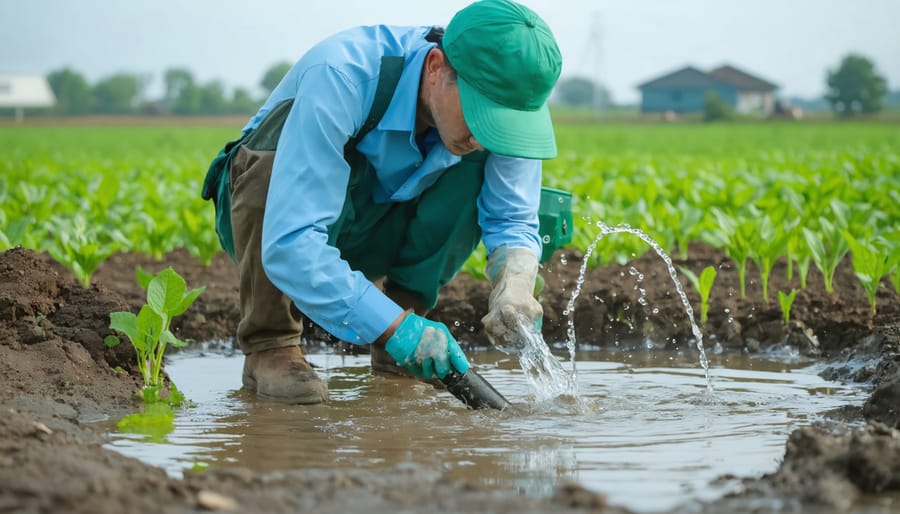
Well Maintenance and Testing
Regular well maintenance is crucial for ensuring a reliable and safe groundwater supply for your farm. Start by conducting monthly visual inspections of your well cap, casing, and surrounding area. Look for signs of damage, cracks, or potential contamination sources within 100 metres of your well.
We recommend testing your water quality at least twice yearly – typically in spring after the snow melt and in late fall. Work with certified laboratories in Alberta to test for common contaminants like coliform bacteria, nitrates, and dissolved solids. Keep detailed records of all test results and maintenance work for future reference and regulatory compliance.
Preventive maintenance should include annual professional inspections to check pump performance, water levels, and flow rates. During these checks, ensure your well screen is clean and functioning properly. If you notice decreased water pressure or unusual sediment in your water, schedule an immediate inspection.
Consider installing monitoring equipment to track water levels and quality changes over time. Many Alberta farmers have found success using automated systems that provide real-time data about their well’s performance.
Remember to maintain a buffer zone of natural vegetation around your well to prevent soil erosion and reduce the risk of surface contamination. If you’re unsure about any maintenance procedures, consult with local well contractors or Alberta Agriculture and Forestry experts for guidance. They can provide region-specific advice based on your well’s characteristics and local groundwater conditions.
Contamination Prevention
Protecting our groundwater from contamination is crucial for sustainable farming in Alberta. As stewards of the land, we have a responsibility to prevent water contamination through proactive management practices.
Start by establishing buffer zones of at least 30 metres between water sources and areas where you apply fertilizers or pesticides. These natural barriers help filter potential contaminants before they reach groundwater systems. Regularly inspect and maintain your storage facilities for agricultural chemicals, ensuring they’re properly sealed and located away from wells and water sources.
Timing is everything when it comes to fertilizer application. Schedule applications during optimal weather conditions and soil moisture levels to minimize leaching. Consider split applications rather than single heavy doses, which can help reduce the risk of nutrients seeping into groundwater.
Implement proper well maintenance by regularly testing water quality and inspecting well casings for damage. Keep detailed records of these inspections and any maintenance performed. Installing monitoring wells can help track groundwater quality and provide early warning of potential contamination issues.
For livestock operations, ensure manure storage facilities are properly lined and maintained. Regular soil testing can help determine appropriate application rates and timing, preventing excess nutrients from reaching groundwater systems. Consider working with local conservation authorities to develop a farm-specific contamination prevention plan that addresses your unique needs and challenges.
Regulatory Compliance and Support
Understanding Water Rights and Permits
In Alberta, managing groundwater starts with understanding your water rights and obtaining the necessary permits. Under the Water Act, most agricultural operations requiring groundwater withdrawal need a water licence or approval from Alberta Environment and Protected Areas.
For farming operations, the first step is determining whether your intended water use falls under household, traditional agricultural, or licensed use. Traditional agricultural users who began using water before 1999 can register their water use as a historical right, protecting their long-term access.
New agricultural operations typically need to apply for a water licence, which specifies the volume of water you can withdraw, the source location, and the purpose of use. The application process involves submitting detailed information about your operation, including expected water requirements and potential environmental impacts.
Before drilling a new well, you’ll need to work with a licensed water well contractor who understands local regulations. They’ll help ensure your well meets provincial standards and can assist with the necessary documentation.
Keep in mind that water licences in Alberta follow the “first in time, first in right” principle, meaning older licences have priority during water shortages. It’s crucial to maintain accurate records of your water use and regularly report usage as required by your licence conditions.
Local Water Services offices can provide guidance through the application process and help you understand your specific requirements. Many farmers find it helpful to connect with their local agricultural fieldman for additional support and resources.
Available Government Resources
Alberta farmers have access to several valuable government programs and resources to support sustainable groundwater management practices. The Canadian Agricultural Partnership (CAP) offers cost-sharing programs specifically designed for water management infrastructure improvements, with funding covering up to 70% of eligible project costs.
The Alberta Water Management Initiative provides technical assistance and grants for installing monitoring wells and implementing efficient irrigation systems. Farmers can apply through their local Agricultural Service Board office, where specialists offer free consultations on project planning and application processes.
Environmental Farm Plan (EFP) participants may qualify for additional funding through the Farm Water Supply Program, which helps offset costs for well drilling, dugout construction, and water conservation technologies. The Growing Forward 3 program also includes specific provisions for groundwater protection projects.
Resources available through Alberta Agriculture and Forestry include:
– Free water quality testing services
– Technical guidelines for well construction and maintenance
– Professional consultation for sustainable water management planning
– Educational workshops and training sessions
– Online tools for calculating water requirements
To access these resources, contact your regional Alberta Agriculture and Forestry office or visit their website. Local watershed stewardship groups also offer community-based support and can help connect you with relevant funding opportunities. Remember to apply early, as many programs operate on a first-come, first-served basis with annual funding cycles.
As we’ve explored throughout this guide, effective groundwater management is crucial for the future of Alberta’s agricultural sector. By implementing sustainable practices like regular monitoring, efficient irrigation systems, and proper well maintenance, we can protect this vital resource for generations to come.
The success stories we’ve seen across Alberta demonstrate that sustainable groundwater management isn’t just an environmental necessity – it’s good business. Farmers who have adopted water-saving technologies and best practices report reduced operational costs and improved crop yields, while contributing to their communities’ long-term water security.
Remember, every action counts. Whether you’re starting with basic well monitoring or implementing advanced precision irrigation systems, each step towards better groundwater management makes a difference. The support network in Alberta, including agricultural extension services, water management experts, and fellow farmers, stands ready to help you succeed in your water conservation journey.
Looking ahead, the future of Alberta agriculture depends on our collective commitment to responsible groundwater use. By working together, sharing knowledge, and embracing innovative solutions, we can ensure our groundwater resources remain sustainable while maintaining productive and profitable farming operations.
Let’s continue to be stewards of our water resources, leading by example in sustainable agricultural practices. Your efforts today will help secure Alberta’s agricultural heritage for tomorrow.

